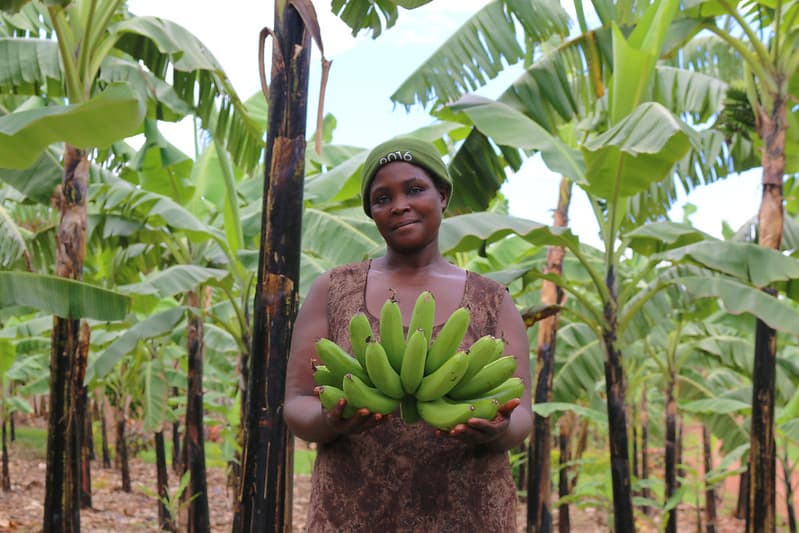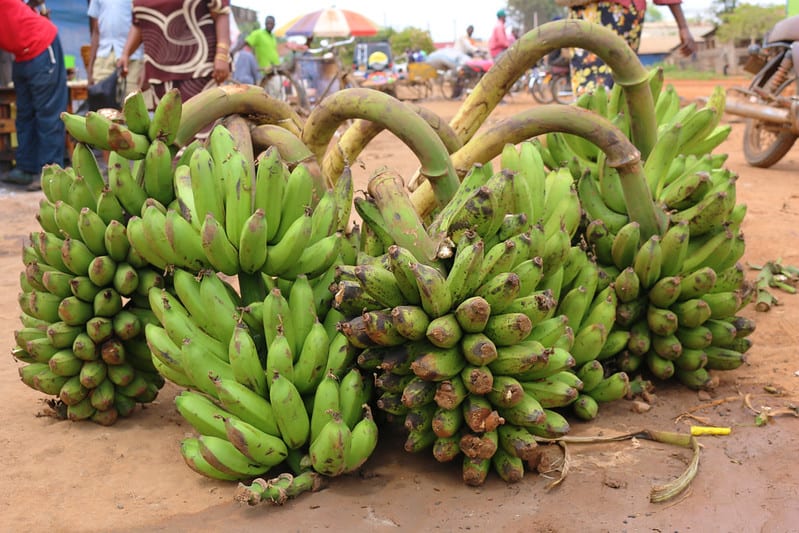
| CGIAR Research Program CGIAR Research Program on Roots, Tubers and Bananas (RTB) |
Partners Bioversity International Makerere University (MAK) National Agricultural Research Organisation (NARO) United States Agency for International Development (USAID) |
Geographic scope Uganda, Burundi |
| Contact person Enoch Kikulwe, Bioversity International |
In Uganda, 600,000 households have adopted technologies developed by the CGIAR Research Program on Roots, Tubers and Bananas (RTB) to manage banana Xanthomonas wilt (BXW). This disease threatens bananas in East and Central Africa and the adoption of control methods has led to greater productivity and economic benefits.
Bananas are some of the most important staple foods in East and Central Africa and are significant sources of income to farmers. Uncontrolled, BXW poses a serious food security risk and threatens the livelihoods of smallholder farmers. CGIAR research crucially determined that single diseased stem removal (SDSR) could play a key role in effectively controlling the disease at much lower cost than the previous recommendation of whole banana mat removal.

Bananas are a significant source of income for farmers in Uganda.
RTB scientists at Bioversity International conducted a study to determine the adoption rates and impacts of control methods for BXW among 1,224 farmers in Uganda.
The study used advanced statistical methods to estimate adoption and the underlying contributory variables for three recommended BXW control methods:
- The early removal of the male flower bud that attracts bees and other insect vectors that carry BXW bacteria;
- Single diseased stem removal (SDSR); and
- Disinfecting metal tools with fire or a sodium hypochlorite solution to keep the disease from spreading to healthy plants.
The study showed that 70% of adopters had used the centrally important SDSR control practice, alone or in combination with others (a small percentage had likely used whole mat removal as it was not practicable to differentiate the practices in the questionnaire). Findings imply that out of an estimated 800,000 banana-growing households, around 600,000 households have adopted some of the BXW control strategies.

Around 600,000 households in Uganda have adopted banana wilt control strategies
A third of the farmers surveyed (33%) were subsistence farmers. These farmers were more likely to adopt all three of the control practices than farmers at other levels – either because bananas are crucial for their livelihoods, or because the practices are easier to adopt in smaller areas. In fact, 41% of the subsistence farmers were using all three practices. Access to off-farm work decreased the likelihood of adopting BXW control practices, suggesting that the more time one has, the easier it is to adopt the control techniques.
The study also found that adoption is constrained by a lack of knowledge of control measures and influenced by the importance of the banana crop to the household. Among the sample farmers, 55% had received training on BXW control; among farmers who adopted the whole BXW control package, 69% received training. Training female farmers increased the likelihood that the household would adopt all three control methods by 9%.
Adopting all three control practices was more profitable than using one or two. Non-adopters earned the least from their banana production. Farmers who received training benefited more by adopting than those who had not been trained. The study revealed that a solid understanding of the technologies allowed farmers to benefit more from the control practices, even among farmers who adopted the whole package. Farmers trained in BXW control methods obtained an average of 176% more value of banana production when they adopted all three practices, while untrained adopters of all three practices earned only 113% more.
A related study found that men do most of the work with banana crop and handle the sales, while women manage bananas grown to eat at home. Men are also more likely to attend training sessions and programs on bananas. However, women’s participation in learning activities increases the potential of women to implement specific practices of the SDSR package.
Work on BXW has also been done in Burundi. The AMASHIGA project has been working with farmer learning groups to manage BXW by SDSR. In one year, the incidence of BXW declined from 15% to less than 1%. RTB is now scaling out this technique given the positive results.
Header Photo: A banana exporter prepares crops for export. Photo by RTB




